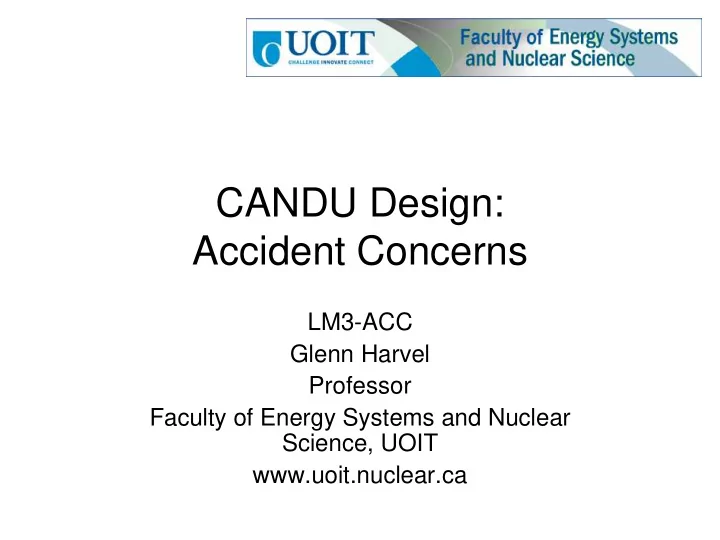

CANDU Design: Accident Concerns LM3-ACC Glenn Harvel Professor Faculty of Energy Systems and Nuclear Science, UOIT www.uoit.nuclear.ca
Learning Objectives • 1. Understand CANDU Behaviour for Accident Scenarios • 2. Understand use of simulator for CANDU Type Accidents
Typical CANDU Production Systems
Class IV Power • Class IV power is regular power. It is supplied from the grid or the main generator. • All normal operating systems are on Class IV power. Most emergency systems are also on Class IV power and rely on Automatic Transfer Switches or other technologies to ensure the switchover occurs properly. • Failure scenarios: – Transformer failure – Damage to transmission line (ice storm) – Blackouts (grid imbalances, etc.)
Consequences of Loss of Class IV • All electrical supply is lost to all components that rely on electricity. • Main heat transport pumps start to run down. Feedwater pumps run down. • Inability to transfer heat from the reactor to the ultimate heat sink. • Systems overheat. Overpressurize. Fuel failures. Loss of pressure boundary. Containment systems are challenged.
Potential Loss of Class IV • Scenario 1 • Spurious Turbine Trip. • All other buses still supplied by station power.
Potential Loss of Class IV • Scenario 2 • 4 PHTS Pumps Trip • All else OK • In reality, other trips occur but I cannot simulate all of them in the CANDU simulator easily.
Potential Loss of Class IV • Scenario 3 • Single PHTS Pump Trip per loop • All other buses still supplied by station power.
LOCA: Pipe Breaks PHTS • Phase I: Blowdown – Heat transport system pressure drops from normal operating level to emergency core cooling injection pressure. • Phase II: Transition ECC – Aka rewetting and refilling. The initial phase of emergency injection when the heat transport system is refilled and the fuel elements rewet (if dryout occurred) • Phase III: Long Term ECC – Post accident recovery phase which removes decay heat
Thermohydraulic Model Non-equilibrium model 2-velocities, A x ia l S e g m e n t (n o d e ) 2-temperatures 2-pressures plus noncondensables Flow regime dependent V e lo c ity V a p o r constitutive relations couple two-phase model Interfaces to other L iq u id codes: B u n d leE le m e n ts Fuel Behaviour Plant Control Physics Winter 2007 ENGR 4520 14
Duration of flow stratification Winter 2007 ENGR 4520 15
Time Scale of Large LOCA Winter 2007 ENGR 4520 16
ECCS Design Functions • Backup Coolant source for Heat Transport System following a LOCA • Provide HT make up inventory • Provide cooling to the reactor core • Remove decay heat from reactor core • Support Heat Transport Loops Isolation (C6) • Support Steam generator Crash Cooldown • Dousing spray to cool R/B and keep pressure below R/B design and add to sump mixture for long term recovery (C6)
Emergency Core Cooling
Other Scenarios • Valve Failures • Loss of Boiler Feed Pumps • Main Steam Line Break • Loss of Regulation • CANDU 9 Simulator – Simulates current CANDU/PHWR technology. – Good for overall understanding of plant operations. • ACR-700 Simulator – Simulates future CANDU concepts. Includes more accident scenarios.
Recommend
More recommend